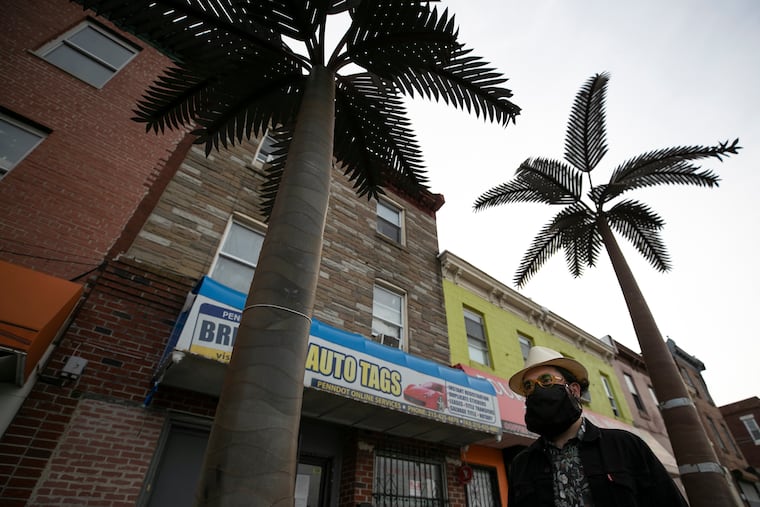The sounds of the coquí frog take over North Philly streets in an art exhibit about Puerto Rico’s soundscape
The sounds are original recordings of the tiny amphibian, taken by sound artist Raúl Romero, in the deepest of the tropical rainforest of Utuado, Puerto Rico.

At the intersection of North Fifth Street and Lehigh Avenue, passersby now hear an unusual sound in their daily commutes, a cacophony typically shaped by street traffic, salsa music and birds singing. Now the loud and high-pitched mating call of the Puerto Rico native coquí frog emerges each afternoon from this urban landscape.
Luz Neida Crespo, a crossing guard at Huntingdon and Fifth Streets, said it was exciting to suddenly find herself listening to the frog’s call in the middle of the city. She said she had never heard the sounds of the frog in such an active environment.
“Listening to coquís, after all that traffic... That’s a good experience,” said Crespo, a Puerto Rican born and raised in Philadelphia’s Fairhill neighborhood.
The sounds — every 20 minutes or so, typically from 1 to 6 p.m. daily along a three-block area — are original recordings of the tiny amphibian, taken by sound artist Raúl Romero, in the deepest of the tropical rainforest of Utuado, Puerto Rico.
Together with printed images of the frog’s sound frequencies and two sculptures that resemble the Arecibo Observatory in Puerto Rico, the singing of the coquí metaphorically calls on anyone who has been to the Caribbean. It is the main attraction in an interactive art show called Onomonopoetics of a Puerto Rican Landscape. The show, which is being played throughout North Philadelphia’s Centro de Oro, explores how Puerto Ricans connect to the island through sound.
Romero, a native of Tampa, Fla., and the artist behind the exhibit, said the intent is to use sound as a vessel and look at the messages carried through it: identity, culture, belonging, pride. For those who have a relationship with the sound, he said, he hopes it evokes feelings and memories of the island. For those who are new to it, he expects to introduce them to what for others is a common soundscape.
“I think of el coquí as this iconic connector, as a bridge, as a transmitter, that shares a cultural identity that travels with the ways we depict it, with its sound,” Romero said.
Puerto Rico’s native coquí (Eleutherodactylus coquí) is a small tree frog, about the size of a penny, named for the very loud mating call that the males make at night. Images and sound representations of the frog are part of Puerto Ricans' cultural identity, based on how Taíno people portrayed the frog in petroglyphs and as a symbol associated with female fertility and children.
Romero, 37, who lives in West Philadelphia and teaches film and sound at the University of the Arts, analyzed the coquís' spectrograms with Carlos Martínez Rivera, a herpetologist at the Philadelphia Zoo, to find ways to present the cultural and the scientific importance of the island amphibian.
The show, coordinated by Taller Puertorriqueño, with support from the Hispanic Association of Contractors and Enterprises (HACE), runs until Jan. 10, 2021. It has a twin exhibit in Miami at the Locust Projects art space.
Rafael Damast, exhibitions program manager at Taller Puertorriqueño and curator for the show, said the exhibit’s subtexts are a treat for Philly’s Caribbean communities, which in this case, he said, could be metaphorically portrayed as small but lively.
“This exhibit brings sounds of nature that resonate with the neighborhood’s community, predominantly from Puerto Rico and the Caribbean, with coding and messaging that only they can decipher.”
For the Philadelphia exhibit, the artist and curator put up posters in the neighborhood, with a phone number and a QR code, for locals to call or scan to share their memories or stories about el coquí, about their homelands, and their reactions to the sound in such an urban space.
Gallery visitors and community residents will be asked about their connection to the frog’s call and to Puerto Rico, and the interviews will be available online for listening.
Lee Kurtz attended the opening reception in October. She said the sounds of the coquí transported her to the days she spent in Puerto Rico in the 1990′s, while visiting a friend. She said she has never forgotten the experience of listening to the frog sing.
“By the middle of the night, my friend had a door that was covered with coquís ... It sounded so beautiful.”
ON EXHIBIT
Onomonopoetics of a Puerto Rican Landscape
Through Jan. 10, 2021 at Taller Puertorriqueño and along N. 5th Street
Exhibit hours 1 p.m. to 4 p.m. Monday-Friday at Taller Puertorriqueño, 2600 N. 5th Street. Outdoors, the exhibit can be heard all day along N. 5th Street between Huntingdon and Cambria Streets, with specially timed soundscapes every 20 minutes from 1 p.m. to 6 p.m..
Admission: Free. Masks required. Additional COVID-19 safety guidelines in effect.